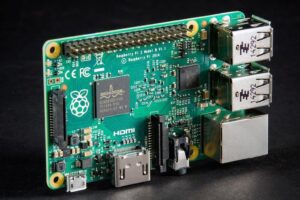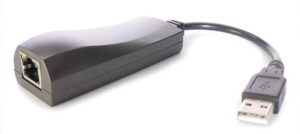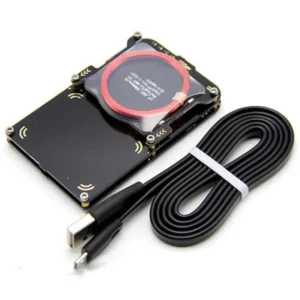Introduction
Ever wondered how those mysterious hackers break into systems? It’s not all about typing furiously into a keyboard like in the movies. A lot of it involves some nifty hardware. Welcome to the world of hacking hardware devices! These little gadgets are the secret weapons in the toolkit of both ethical hackers and cybercriminals alike.
Top 5 Hacking Hardware Devices
1. Raspberry Pi

Overview
Raspberry Pi is like the Swiss Army knife of hacking. This tiny, affordable computer can be used for a plethora of hacking tasks.
Key Features
- Compact size
- Affordable price
- Versatile use cases
Popular Uses
- Building your own server
- Penetration testing
- Creating a portable hacking station
2. USB Rubber Ducky

Overview
Don’t be fooled by its simple appearance. The USB Rubber Ducky looks like a regular flash drive but acts like a keyboard to execute pre-programmed keystroke injection attacks.
Key Features
- Disguised as a USB drive
- Fast and efficient
- Highly customizable
Popular Uses
- Automating repetitive tasks
- Credential harvesting
- Bypassing locked computers
3. Wi-Fi Pineapple

Overview
Wi-Fi Pineapple is your go-to device for Wi-Fi network penetration testing. It can mimic a legitimate Wi-Fi network, tricking devices into connecting to it.
Key Features
- Easy to use
- Powerful Wi-Fi auditing tool
- Real-time monitoring
Popular Uses
- Man-in-the-Middle (MitM) attacks
- Network security audits
- Wireless reconnaissance
4. LAN Turtle

Overview
The LAN Turtle is a covert penetration testing tool that can be plugged into any Ethernet port to provide remote access.
Key Features
- Compact and discreet
- Remote access capabilities
- Plug-and-play
Popular Uses
- Network reconnaissance
- Remote access and control
- Data exfiltration
5. Proxmark3

Overview
Proxmark3 is the ultimate tool for RFID research and pentesting. It can read, analyze, and emulate RFID tags.
Key Features
- Extensive RFID support
- High-frequency and low-frequency capabilities
- Open-source software
Popular Uses
- Cloning access cards
- Analyzing RFID systems
- Security research
Detailed Breakdown of Each Device
Raspberry Pi
Hardware Specifications
-
ARM Cortex-A72 CPU
- 1GB to 8GB RAM options
- Multiple USB ports, Ethernet, HDMI
Why It’s Popular Among Hackers
Raspberry Pi is incredibly versatile and affordable. It’s perfect for beginners and pros alike, offering a hands-on approach to learning and executing various hacking techniques.
Real-world Examples
- Setting up a portable hacking station for on-the-go penetration testing.
- Using it as a network sniffer to monitor and analyze traffic.
USB Rubber Ducky
Hardware Specifications
- ARM Cortex processor
- MicroSD storage
- USB 2.0 interface
Why It’s Popular Among Hackers
Its stealthy appearance and powerful scripting capabilities make it a favorite for social engineering attacks and bypassing security measures.
Real-world Examples
- Deploying a payload to harvest passwords from a locked computer in seconds.
- Automating software installations and configurations.
Wi-Fi Pineapple
Hardware Specifications
- Dual-core processor
- 2.4GHz and 5GHz Wi-Fi support
- USB and Ethernet ports
Why It’s Popular Among Hackers
Wi-Fi Pineapple simplifies Wi-Fi penetration testing, making it accessible even for those with limited technical knowledge.
Real-world Examples
- Performing a Man-in-the-Middle attack to intercept sensitive data.
- Conducting a site survey to identify vulnerable access points.
LAN Turtle
Hardware Specifications
- MIPS 24K CPU
- 64MB RAM
- Ethernet interface
Why It’s Popular Among Hackers
Its plug-and-play nature and remote access capabilities make it an essential tool for network penetration testers.
Real-world Examples
- Gaining remote access to a corporate network by plugging it into a network switch.
- Exfiltrating data from a secure network without being detected.
Proxmark3
Hardware Specifications
- ARM Cortex-M4 CPU
- Supports multiple RFID frequencies
- USB interface
Why It’s Popular Among Hackers
Proxmark3’s extensive RFID capabilities and open-source nature make it a powerful tool for security researchers and penetration testers.
Real-world Examples
- Cloning an employee’s access card to gain unauthorized entry to a building.
- Analyzing and exploiting vulnerabilities in RFID systems.
Why These Devices Are Important
Hacking hardware devices play a crucial role in enhancing cybersecurity, promoting ethical hacking, and advancing education and research. They enable security professionals to identify and fix vulnerabilities before malicious hackers can exploit them.
How to Choose the Right Hacking Hardware Device
Purpose and Use Case
Determine what you want to achieve. Are you focusing on network penetration testing, social engineering, or RFID research? Your goal will dictate the best device for your needs.
Skill Level
Some devices, like the USB Rubber Ducky, are beginner-friendly, while others, like the Proxmark3, require more advanced knowledge.
Budget Considerations
Hacking hardware devices vary in price. Raspberry Pi is an affordable option, while Proxmark3 can be more expensive. Balance your needs with your budget.
Getting Started with Hacking Hardware
Basic Requirements
- A reliable computer
- Necessary software and drivers
- Basic knowledge of networking and programming
Setting Up Your First Device
Start with a Raspberry Pi or USB Rubber Ducky. Follow online tutorials and guides to get your device up and running.
Learning Resources
- Online forums and communities
- YouTube tutorials
- Courses on platforms like Udemy or Coursera
Conclusion
Hacking hardware devices like Raspberry Pi, USB Rubber Ducky, Wi-Fi Pineapple, LAN Turtle, and Proxmark3 are essential tools for anyone interested in cybersecurity. Whether you’re a beginner or a seasoned pro, these devices can help you enhance your skills, secure networks, and contribute to the field of cybersecurity.
FAQs
What is the best hacking hardware for beginners?
Raspberry Pi is an excellent choice for beginners due to its versatility and affordability.
Is it legal to own hacking hardware devices?
Yes, it is legal to own hacking hardware devices, but using them for illegal activities is against the law.
Can hacking hardware be used for good purposes?
Absolutely! Ethical hackers use these devices to identify and fix security vulnerabilities.
What should I consider before buying a hacking hardware device?
Consider your goals, skill level, and budget before purchasing a hacking hardware device.
Where can I learn more about using hacking hardware devices?
There are numerous online resources, including forums, YouTube tutorials, and courses on platforms like Udemy and Coursera.
0 Comments